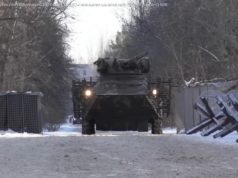The war between Russia and Ukraine will have no winner. Where are the leaders from NATO pushing peace talks between the countries?
Russia strikes targets inside Ukraine. NBC News screen capture. WASHINGTON — The Ukrainian and Russian languages have the same word for peace. In Cyrillic it is мир – pronounced “myr” or “mir.” Yet, while there have been proposals on how to move toward a ceasefire and peace put forward by the Russian government, the Ukrainian leader President Zelensky has rejected all offers to date. Despite pressure by both the United States and NATO officials, Ukrainian leadership refuses to formally “concede” to any terms or conditions proposed by Russian President Putin. Meanwhile, Ukrainians and Russians continue to suffer and die. Russia continues to lay waste to cities and towns in Ukraine. Displaced persons and refugees now number in the millions. So who or what continues to obstruct real, productive peace talks between Russia and Ukraine? Daily reporting on the situation in different sectors of Ukraine concoct another type of warfare of scale. Psychological war has escalated with the help of technologies fabricating locations, events, borrowing from films and using deep fakes to craft their own narratives. All sides participate and test out their new weaponized psyops over Ukrainian territory similar to the testing and showcasing of new weapons used in Spain during the lead up to World War II. Ukrainian and Russian citizen journalists compete with legacy media company newsreaders. Independent reporters are often credible using their language skills and film noir videos. They have more invested than journalists coming from other nations. They and their families live in these countries. However, for news consumers worldwide, the main narrative is to fight. When the media should be calling for peace. The West’ cancel culture crowd ostracizes anyone who comes out for a “reasonable ceasefire.” As they continue the stirring of violence, resurrection of ancient grudges, former injuries, and broken promises. The onlookers in other nations are encouraged to “take sides” and drool over the images of blood lust, devastation, and anguish. With the use of phones and live streaming anyone with an internet connection, anywhere in the world can view the horror of war like they would a video game. They can root for their side as they might for their favorite sports team. Onlookers can be included in the second by second action of shooting prisoners of war ( by the Ukrainian army and militias, for example). Or the bombing of entire neighborhoods. They can listen to interviews with women and children sheltering in bunkers for over a month in Mariupol or camping in internally displaced persons (IDP) tents in the winter. They can watch Ukrainian soldiers harassing and mocking the mothers of Russian soldiers they killed and film themselves doing it, then post these vile videos online. Still no legacy or mainstream media is promoting or focusing on strategies toward peace. It is as if “peace” or “ceasefire” are canceled. Installed Ukrainian president Zelensky indeed will not utter these words aloud. Hypocritically, former proponents and implementers of massive bombing campaigns against sovereign nations such as the former Yugoslavia, Iraq, Libya, and Afghanistan, try to condemn Russians and President Putin for actions that pale in comparison to their legacies of destruction and death.






